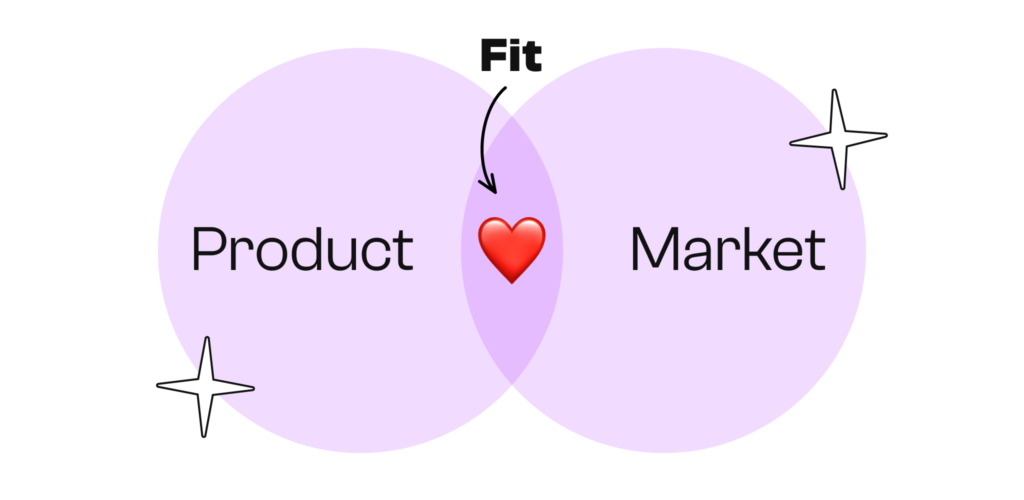How to get Product-Market Fit right. With Intercom’s Lorenzo Teodori.
It all starts from the initial phase, where usually there’s an idea, often based on personal insights or needs expressed by existing customers. After that, all entrepreneurs and managers ask themselves crucial questions:
- Definition – which product idea is the right one to invest in?
- Acquisition – once the first version is created, how do I acquire enough customers to make it grow?
- Growth – afterwards, how do I keep the product in the minds and habits of my customers?

In this article, we address these questions with the contribution of an expert who works daily in one of the most successful digital companies: Lorenzo Teodori, Senior Product Manager at Intercom. Before joining the Intercom team, Lorenzo founded his startup, Taskhunters, which helped students earn money by doing jobs for individuals and small businesses. Later, Lorenzo gained experience as a Product Manager in companies like Nexmo and Vonage.
The theme of this article is Product-Market Fit, which means how to turn a product idea into a market-appreciated success. Here are the topics we will cover:
- 🤔 What is Product-Market Fit?
- 🔎 From ”interesting” to “exceptional”: how Taskhunters found its market
- 💡 How to understand customer needs?
- 🎁 How does a Product Manager work at Intercom?
- 🛠️ Does talking about MVP (Minimum Viable Product) still make sense?
- 🤯💪 🌈 Bonus: The road to Product-Market Fit is often long or challenging – what to do to avoid getting stuck?
🤔 What is Product-Market Fit?
Product-Market Fit is developing a product or service that effectively solves a specific market problem.
There are two pretty typical situations:
- Zero to One – searching Product-Market Fit for a startup, where the first problem to offer a solution is identified.
- Scaleup – searching Product-Market Fit for an existing product that requires improvements or new features.
In both cases, it is necessary to follow a series of steps, including identifying the target market and collecting feedback, to understand the users’ real problems. A value proposition must then be defined, and a minimum viable product developed, tested, and iterated until scalability is achieved.

That’s the theory. But how do you practically pursue Product-Market Fit?
It is essential to focus first and foremost on the main problem you want to solve and always keep the focus on users, discarding anything unnecessary and concentrating on essential features. You need to ask yourself:
- What is the pain point of my users?
- What are the essential things to move quickly and obtain the necessary feedback to learn and iterate?
But be careful; Product-Market Fit starts with cultural imprinting: if you intend to create a new company or startup, it is advisable to integrate a user-focused approach into the company culture from the beginning, almost as part of the company mission.
At Intercom, one of the core principles is to be “customer-obsessed.” This allows us to focus on user needs constantly. It is also essential to incorporate this focus into product development rituals, such as problem exploration, which should always be done in collaboration with the users.
In Intercom, it is common practice to conduct interviews with a group of users to verify that the problem we want to solve is real. And it doesn’t end there: we maintain constant collaboration with users even during the solution design phase. This requires creating an empathetic connection: prototypes are shown, and continuous feedback is collected, which is then used to adjust the course in subsequent development phases.
🔎 From “interesting” to “exceptional”: how Taskhunters found its market
Lorenzo founded Taskhunters as a student looking to earn money to cover expenses. He wanted to create a service that could be useful to students seeking work and individuals looking to delegate small daily tasks.
The original version of the service was accessible through a mobile app and was based on the assumption that some individuals who didn’t have time to perform small daily errands but were willing to pay to delegate these tasks to others.
However, once the product was launched, the team started encountering unexpected problems.
🔎 Problem – They noticed that after the initial interaction on Taskhunters, students and clients tended to bypass the platform and make arrangements offline. This was a significant issue for the team, so they analyzed the data and focused more on users to understand where the problem resided.
🧐 Analysis – In doing so, they identified a small group of users who continued to use the platform even after the initial use. Who were they? Small business owners who wanted to keep using Taskhunters because of the bureaucratic simplification and responsiveness offered by the service, thanks to the large number of available workers.
🤩 Solution – It was an important and recurring problem: this is where Taskhunters could pursue its Product-Market Fit. By focusing on the B2B market, acquisition cost and return rate improved significantly, and the service began to gain traction.
Read more: Taskhunters – Shipping an MVP in just two months
💡 How to understand customer needs?
The Jobs-to-be-done framework, created by Clayton Christensen and Bob Moesta, helps define users’ needs, requirements, and desires. When working on a product idea, we often start talking about features and solutions. However, it is essential to start from the problem. JTBD is a valuable tool for communicating with developers and helping them understand the context and purpose of their work. Still, its actual value lies in assisting in thinking about what to do before actually doing it.
In Taskhunters, for example, the hypothesis was that individuals would be willing to pay to save time. However, that was not the case, and there was not enough demand. It was necessary to look elsewhere. It is always necessary to discover if the initial hypothesis is correct.
- Define the JTBD – start with defining the problem.
- Conduct interviews – delve into the real experience of your customers or potential users and build “Job Stories” (concrete examples that describe real users and their needs).
- Solutions – define specs, use cases, and detailed functionality.
Read more: Practical guide to Jobs-to-be-done
🎁 How does a Product Manager work at Intercom?
The role of a Product Manager can vary from company to company. In Intercom, the role of the Product Manager is primarily strategic, although supervision until implementation and subsequent user adoption is required.
Lorenzo says:
“My work starts every morning with a review of all the customer feedback received the previous day or night. I need to identify the priority feedback and assess how to adjust the overall product roadmap. I schedule interviews with customers for new features to understand if we are solving the right problems in the right way. I participate in various daily meetings, such as stand-ups, during which I question the engineers to gather technical feedback that helps refine problem definition. I answer their questions about what they are building and the status of current product features.”
While primarily focusing on strategy, the work of a Product Manager at Intercom encompasses the entire product development cycle:
- Once the problem is defined, the PM collaborates with designers to solve it and establish an overall vision for the solution.
- They begin scoping this vision, understanding which features are necessary and will have the most impact.
- The PM continues to monitor tests and analyze results to evaluate their impact. Problem definition also entails defining success metrics and monitoring them.
🎨🔬 How is the collaboration between Product Manager and designers at Intercom?
Designers and Product Managers always work together as equals, each being an expert in their respective domains. No one considers themselves superior to the other; there is a balanced partnership. The PM typically guides the strategy, vision, backlog, and problem definition, while the designer leads the definition of the solution. The Product Manager is a sort of sidekick who continually provides feedback because they have a better understanding of the customers.
🛠️ Does talking about MVP (Minimum Viable Product) still make sense?
- For a startup – expediting the process and releasing an MVP can be beneficial, sometimes even without the need to write code. With Taskhunters, for example, the first MVP was a Facebook group. This allowed for gathering feedback and quickly integrating it into the service’s development.
- For a scaleup – if you work in a more mature company, the balance between quality and speed needs to be more even; it is not always advisable to release only a portion of the features or, worse, a product with bugs. It requires “working with scoping,” releasing the product as quickly as possible to obtain feedback rapidly.
However, speed does not mean approximation: one should not release poorly executed features or ones with obvious bugs. Instead, it is better to focus on perfectly solving a well-defined problem.
It’s a matter of company culture. In Intercom, only high-quality features and products are allowed to be released. Balancing quality and timelines is not always easy, but sometimes the company’s maturity does not allow otherwise. Intercom is a benchmark in terms of product quality.
As a principle, Intercom only delivers if it is excellent.
🤯💪 🌈 Bonus: The road to Product-Market Fit is often long or challenging – what to do to avoid getting stuck?
When you have an idea and want to know if you’re addressing a real problem, it’s important to share it early with others and evaluate if they show interest. Being user-focused is crucial, as mentioned before. In other words, an idea has no value if it doesn’t have a user base that finds it useful.
To ensure there is a market for that idea, it’s helpful to assess if there are competitors who, in one way or another, are trying to solve the same problem.
We are often inclined to think that the presence of competitors is a negative sign for a startup. That’s not the case: their presence indicates that the problem we’re addressing is relevant. Instead, it’s important to consider how to differentiate ourselves, such as by introducing innovation in the user experience, offering a lower cost, or targeting an underserved niche market.
When it comes to developing an entrepreneurial idea, one of the crucial phases is market analysis to understand the potential return on investment. It is a fundamental operation that translates a problem into a business opportunity. Market analysis helps to assess the feasibility of the project and predict the potential success of the entrepreneurial proposition. This way, you can evaluate if the idea has enough potential to justify the investment of resources and time required to pursue it. The importance of thorough market analysis should not be overlooked in assessing whether an idea has the necessary potential to become a real and sustainable business.